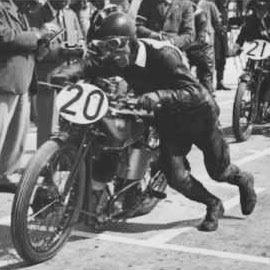In the 1920s and 30s, when the highways and byways of the Borders echoed to the sound of a motorbike at great speed, people would simply say: ‘Guthrie’. They were talking about a quiet man who today is remembered as one of the greatest-ever motorcycle riders.
Born in Hawick in 1897, Jimmie Guthrie’s passion for motorcycle racing began in earnest when he returned from service in World War I. He and his brother Archie joined their local motorcycle club and participated in local hill climb and grass track races, before Jimmie was nominated by the club to race in the 1923 Isle of Man TT.
He didn’t distinguish himself in the race, but the bug had bit. He continued a competitive career, achieving his first major win at the Scottish Speed Championships in St Andrews in 1926 and again the following year.
Jimmie returned to the Isle of Man in 1927, this time finishing second. He finally won the lightweight race at the 1930 TT, and would go on to win a further six times in the following seven years. The year 1930 also saw the first of an astonishing 19 Grand Prix victories around the world. And the next year, he established world speed records on the Montlhéry circuit near Paris over 50km, 50 miles, 100km and 100 miles.
After joining the Norton team, he won the 1934 500cc North West 200, the junior and senior double at the 1934 TT and a second 500cc North West 200 in 1935. The same year, he won his first European Championship, a title he held for three consecutive years.
Guthrie’s 14-year career and incredible run of achievements came to an end when, aged 40, he died from injuries sustained in a crash during the German Grand Prix on 8 August, 1937. The Guthrie Stone was later erected on the course to commemorate his final race. A publicly-funded memorial was also erected on the Isle of Man TT circuit.
